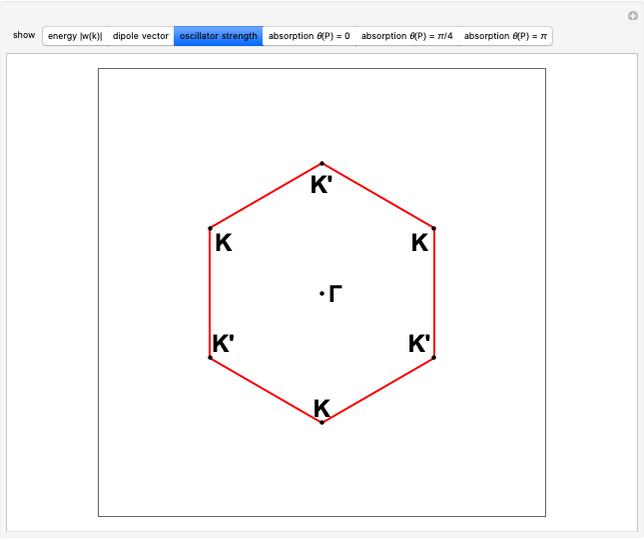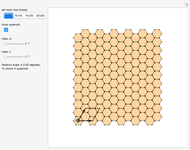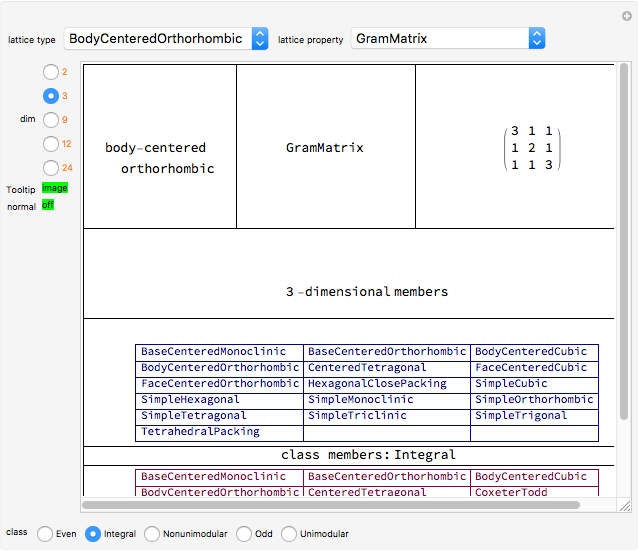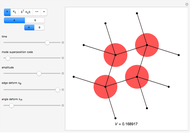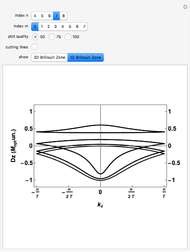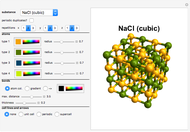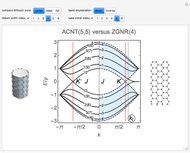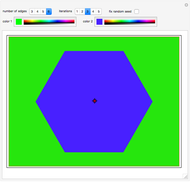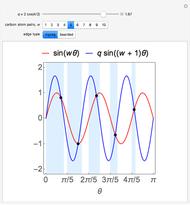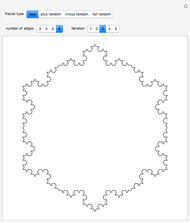Zigzag-Shaped Graphene Nanoribbons

Requires a Wolfram Notebook System
Interact on desktop, mobile and cloud with the free Wolfram Player or other Wolfram Language products.
This Demonstration presents the atomic structure of superlattices based on graphene nanoribbons. All the structures have the same wiggly shape but different connections of edges.
Contributed by: Vasil Saroka (August 2017)
Open content licensed under CC BY-NC-SA
Snapshots
Details
The unit cell of a zigzag-shaped graphene nanoribbon is described by these three lattice vectors of the honeycomb graphene lattice:
 (red),
(red),
 (blue) and
(blue) and
 (green),
(green),
where  ,
,  and
and  are elementary lattice vectors and
are elementary lattice vectors and  ,
,  and
and  are integers [1, 2].
are integers [1, 2].
The crystallographic orientation of the elementary vectors  and
and  defines the ribbon edges to be of type zigzag (
defines the ribbon edges to be of type zigzag ( ) or armchair (
) or armchair ( ). The apex angle is the angle between vectors
). The apex angle is the angle between vectors  and
and  . The edge type and the apex angle are used for classifying the wiggly structures. The snapshots present the four types of zigzag-shaped graphene nanoribbons.
. The edge type and the apex angle are used for classifying the wiggly structures. The snapshots present the four types of zigzag-shaped graphene nanoribbons.
Snapshot 1: zigzag edges with an apex angle of  (
( )
)
Snapshot 3: armchair edges with an apex angle of  (
( )
)
Snapshot 4: armchair edges with an apex angle of  (
( )
)
The crystallographic orientation of the third elementary vector  determines the width ratio between the two fragments of the zigzag-shaped ribbon. The widths of fragments built on the vectors
determines the width ratio between the two fragments of the zigzag-shaped ribbon. The widths of fragments built on the vectors  ,
,  and
and  ,
,  are meant to be measured perpendicular to the vectors
are meant to be measured perpendicular to the vectors  and
and  . The width ratio is set to unity in this Demonstration, though a more generic case can also be considered [3].
. The width ratio is set to unity in this Demonstration, though a more generic case can also be considered [3].
The integers  ,
,  and
and  specify the length and the width of the zigzag-shaped ribbon unit cell. The whole ribbon is obtained by repeated translation of the unit cell by
specify the length and the width of the zigzag-shaped ribbon unit cell. The whole ribbon is obtained by repeated translation of the unit cell by  . In this Demonstration, only a few unit cells are shown for clarity.
. In this Demonstration, only a few unit cells are shown for clarity.
A similar approach to the classification and atomic position generation can be applied to other two-dimensional crystalline structures, for example, silicene quantum dots [4].
The atomic coordinates generated in this Demonstration can be used for calculating physical properties of zigzag-shaped ribbons, for example, their electronic properties [1, 2]. The optical properties of these structures can be calculated as described for zigzag ribbons with straight edges [5].
Graphene nanoribbons very close in shape to those presented here have been produced by the self-assembling of subtly engineered organic molecular precursors [6].
References
[1] V. A. Saroka, K. G. Batrakov and L. A. Chernozatonskii, "Edge-Modified Zigzag-Shaped Graphene Nanoribbons: Structure and Electronic Properties," Physics of the Solid State, 56(10), 2014 pp. 2135–2145. doi:10.1134/S106378341410028X.
[2] V. A. Saroka, K. G. Batrakov, V. A. Demin and L. A. Chernozatonskii, "Band Gaps in Jagged and Straight Graphene Nanoribbons Tunable by an External Electric Field," Journal of Physics: Condensed Matter, 27(14), 2015 145305. doi:10.1088/0953-8984/27/14/145305.
[3] V. A. Saroka and K. G. Batrakov, "Zigzag-Shaped Superlattices on the Basis of Graphene Nanoribbons: Structure and Electronic Properties," Russian Physics Journal, 59(5), 2016 pp. 633–639. doi:10.1007/s11182-016-0816-6.
[4] H. Abdelsalam, M. H. Talaat, I. Lukyanchuk, M. E. Portnoi and V. A. Saroka, "Electro-absorption of Silicene and Bilayer Graphene Quantum Dots," Journal of Applied Physics, 120(1), 2016 014304. doi:10.1063/1.4955222.
[5] V. A. Saroka, M. V. Shuba and M. E. Portnoi, "Optical Selection Rules of Zigzag Graphene Nanoribbons," Physical Review B, 95(15), 2017 155438. doi:10.1103/PhysRevB.95.155438.
[6] F. Schulz, P. H. Jacobse, F. F. Canova, J. van der Lit, D. Z. Gao, A. van den Hoogenband, P. Han, R. J. M. Klein Gebbink, M.-E. Moret, P. M. Joensuu, I. Swart and P. Liljeroth, "Precursor Geometry Determines the Growth Mechanism in Graphene Nanoribbons," The Journal of Physical Chemistry C, 121(5), 2017 pp. 2896–2904. doi:10.1021/acs.jpcc.6b12428.
Permanent Citation






